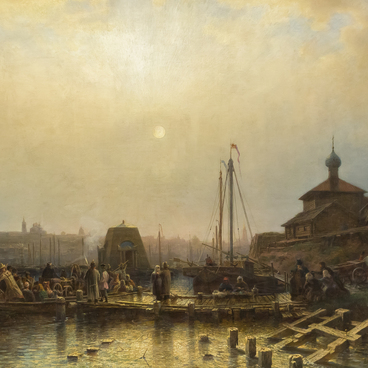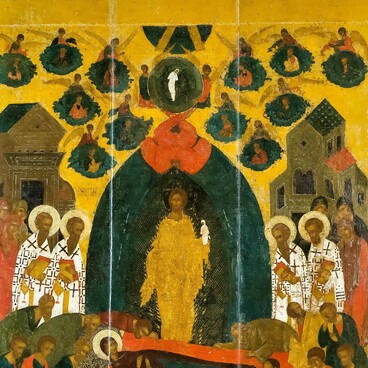‘Still Life with Fruit and Flowers’ was painted by a Dutch artist Jan van Os. The exact year of this painting is unknown — it can only be supposed that it was created in the second half of the 18th century.
Jan van Os rendered the features of every flower and fruit: he depicted the tenderness of rose petals, the velvety skin of ripe grapes, and the spiky leaves of the pineapple. In the background, there is a landscape with trees and arches of a stone bridge. The contrasting sky sets a special mood for the painting — it is light at the horizon and yet gloomy above the flowers.
The Dutch still life has an interesting history. In the 17th century, during the struggle for independence from Spain, the Netherlands was divided in two territories — Holland and Flanders. Unlike in Catholic Flanders, the Church almost stopped commissioning paintings in Protestant Holland. However, art started to gain popularity among other social groups. The level of life improved, so that even poor peasants could decorate their homes with paintings of talented artists.
Historical and mythical scenes did not appeal to the common folk, for they preferred everyday scenes and colorful still lifes that were more authentic and down to earth. The artists listened to their clients’ requests, which contributed to the development of a new movement in the 17th century Dutch art.
The Dutch painters strived for excellence, that is why they often narrowed down their subjects. At that point in time, the genre of still life began to divide into subgenres, depending on the subjects chosen for the painting. There were flower and kitchen still lifes, as well as fishmonger’s and hunting shops. The ‘vanitas’ movement — a thought-provoking moral still life that depicts a skull to remind about the transience of life — was especially significant.
‘Still Life with Fruit and Flowers’ by Jan van Os belongs to the subgenre of fruit and flower still life. In the 18th century, such scenes were once more in fashion. For all their splendor and ornateness, they reflected the real life of the Dutch, many of whom at that time were fond of gardening and floriculture. Authenticity was in demand, so artists would often paint flowers from life. Many painters placed bright objects against a contrasting dark background.
Jan van Os was born in Middelharnis in 1744. Later in life, he went to study in The Hague, where he would spend the rest of his life. In 1773, he was accepted to the painters’ confraternity. In the beginning of his career, he created seascapes, but became famous for his flower and fruit still lifes. They were esteemed for their vivid colors, slight nuances of shade and masterfully outlined detail.
Jan van Os rendered the features of every flower and fruit: he depicted the tenderness of rose petals, the velvety skin of ripe grapes, and the spiky leaves of the pineapple. In the background, there is a landscape with trees and arches of a stone bridge. The contrasting sky sets a special mood for the painting — it is light at the horizon and yet gloomy above the flowers.
The Dutch still life has an interesting history. In the 17th century, during the struggle for independence from Spain, the Netherlands was divided in two territories — Holland and Flanders. Unlike in Catholic Flanders, the Church almost stopped commissioning paintings in Protestant Holland. However, art started to gain popularity among other social groups. The level of life improved, so that even poor peasants could decorate their homes with paintings of talented artists.
Historical and mythical scenes did not appeal to the common folk, for they preferred everyday scenes and colorful still lifes that were more authentic and down to earth. The artists listened to their clients’ requests, which contributed to the development of a new movement in the 17th century Dutch art.
The Dutch painters strived for excellence, that is why they often narrowed down their subjects. At that point in time, the genre of still life began to divide into subgenres, depending on the subjects chosen for the painting. There were flower and kitchen still lifes, as well as fishmonger’s and hunting shops. The ‘vanitas’ movement — a thought-provoking moral still life that depicts a skull to remind about the transience of life — was especially significant.
‘Still Life with Fruit and Flowers’ by Jan van Os belongs to the subgenre of fruit and flower still life. In the 18th century, such scenes were once more in fashion. For all their splendor and ornateness, they reflected the real life of the Dutch, many of whom at that time were fond of gardening and floriculture. Authenticity was in demand, so artists would often paint flowers from life. Many painters placed bright objects against a contrasting dark background.
Jan van Os was born in Middelharnis in 1744. Later in life, he went to study in The Hague, where he would spend the rest of his life. In 1773, he was accepted to the painters’ confraternity. In the beginning of his career, he created seascapes, but became famous for his flower and fruit still lifes. They were esteemed for their vivid colors, slight nuances of shade and masterfully outlined detail.



